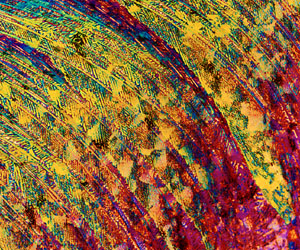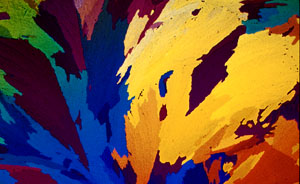From Under the Microscope to
Over the Platen
Science is science, and art is art, you say? Think again, suggests Michael Davidson. For the biophysicist turned artist, the two have not only met, but become a way of life through screen printing.
Science is science, and art is art, you say? Think again, suggests Michael Davidson. For this biophysicist turned artist, the two have not only met, but become a way of life through screen printing.
A research scientist at the National High Magnetic Field Laboratory in Tallahassee, FL. Michael Davidson first used photomicrography-photography of objects placed under a microscope glass-when he was studying the internal makeup of human cells, viruses, and other organisms as a graduate student at Florida State University (FSU). Back then, he had no clue that his microscope sightings would evolve into colorful garment designs.
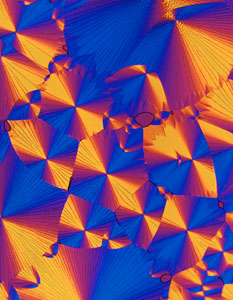
|
|
Biotin |
After years of photographing the samples, Davidson realized that printing the elaborate patterns that he saw through his microscope onto consumer products like T-shirts and neckties could be a creative way to promote science education. So last year, he prepared a portfolio featuring a wide range of his micrographs-from vitamins to superconductors to medicines- and sent them off to some 300 screen-printing companies across the country.
A Commercial Splash
The response was better than Davidson expected. His creative way to teach science through art found instant, eager-to-learn students, including three textile printers.
Both New York, NY's Stonehenge, Ltd., a neckwear manufacturer, and Danskin, an activewear apparel manufacturer, believe that Davidson's teaching method represents a healthy way to capitalize on buying habits of fitness-conscious consumers. They have signed on to screen print and market the images. But for Vance Roberts, marketing director of Daytona Beach, FL-based transfer manufacturer Joe Cool, Inc., the idea represents something worth betting more on. After reading a newspaper article about Davidson's work, Roberts decided to launch his own business, Microscape, Inc., solely to market garments printed with Davidson's micrographs.
Alpha-Topcopherol (Vitamin E)
Davidson hopes that this metamorphosis of science and art can grow into a national-perhaps international-trend. He's personally handling the marketing and publicity work, but has also employed Premier Signatures International, a New York, NY, licensing and merchandising company, to keep track of the steadily growing list of clients.
"We want to make as big a commercial splash as possible," Davidson stresses. But what keeps this man plugging on is what got him started-science research. Not surprisingly, proceeds from the project are being used to fund science education at FSU. The university has already grossed approximately $40,000.
A Different Approach
The three companies that have signed on to print Davidson's work on garments find his nontraditional form of art inviting.
"When we saw the vitamins, we decided it would be a different approach for us-something new," says Ruth Gordon, director of textiles and design at Danskin, a company that's screen printing the vitamins on T-shirts for health clubs, sporting-goods stores, and specialty shops. "We are used to looking at hand-drawn or hand-painted designs. This was a fresh approach as well as a good blend of science and art. And, of course, the vitamins appealed because we are a fitness oriented company," she explains.
Thiamine (Vitamin B1)
In its negotiations with potential clients, Microscape, too, is emphasizing the same point-that science and health messages can be communicated in beautiful, alluring ways. Recently, the company acquired a license to be the only screen printer of the micrographs on T-shirts and sweatshirts in the future.
Stonehenge is not far behind in capitalizing on this concept. It is targeting doctors and scientists as a market to sell neckties featuring the vitamins. "Those people are just going to go crazy over these," says Irwin Sternberg, president of the company. But something is there for the retailers, too, he adds. "The retail community is looking for new ideas-not another stripes or paisley tie."
From the Lab to the Garment
Before celebrating their combo science-and-art success, there's something else that these marketers must tackle-ways to print those complex patterns without losing the detail and colors. Just as Davidson tinkered with his vitamin specimens for almost six years-heating or dissolving them in order to crystallize and photograph them- the screen printers have to tinker with their production methods to reproduce the images accurately.
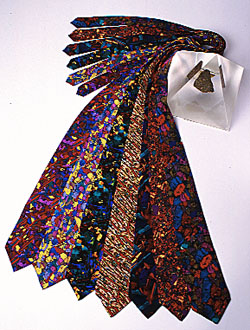
Neckties
Necktie manufacturer Stonehenge believes retailers want something new, not a striped or paisley tie.
Danskin prints the four-color-process images on its own 100%-cotton blanks, using plastisol inks on an automatic press. The company usually does its own color separations, but the details in the micrographs prompted it to hire an outside separator, explains Jeff Rexroth, department manger of the screen printing.
In addition, screen printing the micrographs requires a higher mesh count to hold the fine details. While Danskin typically uses a 137-195 tpi mesh, it has to use a 305 tpi mesh to print the micrograph images, Rexroth says.
Stonehenge, on the other hand, is taking the health-plus-art concept across the globe. It is sending its work to various Korean shops, including Seoul-based Ilbo Industries, to be color separated and printed. "After Michael sends us the photographs, we reshoot them. Then we send certain parts of those shots to our Korean mills. They do the color separations as well as the printing," Sternberg explains.
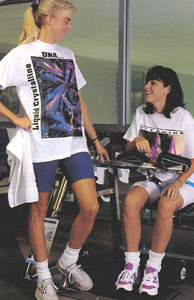
Davidson's creative way to teach science through art found eager-to-learn students.
Ilbo manually prints the images one color at a time on bolt cloth spread on a 50-yd-long table, describes Connie Chung, New York sales rep for the company. After one printer lays down one color and moves on, the next printer follows to lay down the second color.
The Korean mills send the printed fabric back to Stonehenge, which then cuts and sews it into ties. The arrangement with the Korean printers works well for the firm, Sternberg maintains, but sometimes there are slight differences in colors." (The prints) might come back in bright red, for example, when the originals were only a medium red."
Color Shift is one of Microscape's challenges as well. Now that it is the exclusive licensee to print the micrographs on T-shirts and sweatshirts, the company is determined to minimize this and other problems in printing the elaborate patterns. It is considering contracting the printing to different screen printers. Currently, it is negotiating with four Florida printers, including Tampa-based Rainbow Graphics, Roberts says. If awarded the job, the firm will use four-color-process printing, initially churning out about 1200 shirts per press run. Roberts estimates, emphasizing that he will supervise the quality control.
Tags that Educate
For 42-year-old Davidson, quality control is not the only issue. It is important to him that the printed garments also carry his message to consumers. The screen printers are helping by providing information on the vitamins, drugs, and other materials printed on the garments.
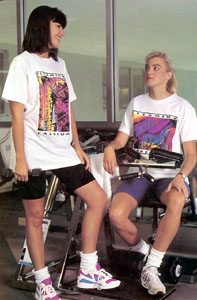
Garment manufacturers must find ways to print these complex patterns without losing the detail and colors.
"One side of the tags attached to our T-shirts will carry the Microscape logo printed in gold. The other side will have information on the particular print- whether it be AZT (AIDS drug zidovudine), a DNA, or whatever," Roberts says. "We'll also include information on the microscope that Michael used."
Thiamine
Similarly, Stonehenge's neckties will be sold with accompanying literature on the vitamins. "We'll tell how the vitamins can help and what they prevent," Sternberg says.
Danskin, on the other hand, prints the information directly on the T-shirt back. The print looks like a page out of the dictionary, defining "vitamins" as "organic molecules essential to metabolism in all living organisms."
Quite Fashionable
That "essential" science is already adorning some people's birthday gifts as wrapping paper and walls as calenders, marketed by Amber Lotus, an Oakland, CA-based paper products company. After all, textile screen printers are not the only ones capitalizing on Davidson's idea; other consumer-goods marketers have been taking advantage of it for a couple of years now. Textile printers, however, are bringing the concept even closer to people's everyday lives- in the form of T-shirts and neckties.
As for Davidson, he's still overwhelmed by the audience his science-and-art philosophy has attracted. Today, he has more than 50,000 micrographs to his name. His work has already captured the pages of several scientific journals and consumer magazines. He even made it to national television and was interviewed this summer on ABC's "Good Morning America."
"I had no clue it would come this far,' Davidson admits. "I never dreamed of this. I was just looking at crystals."
To reach Premier Signatures International, the licensor of Michael Davidson's merchandise, write 111 W. 57th St., Ste. 1120, New York, NY 10019, 212-245-4580.
